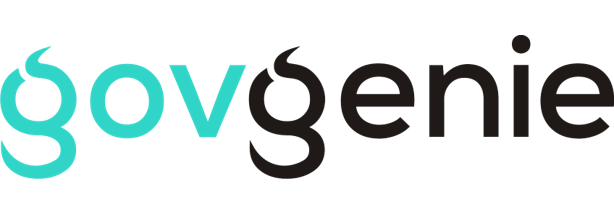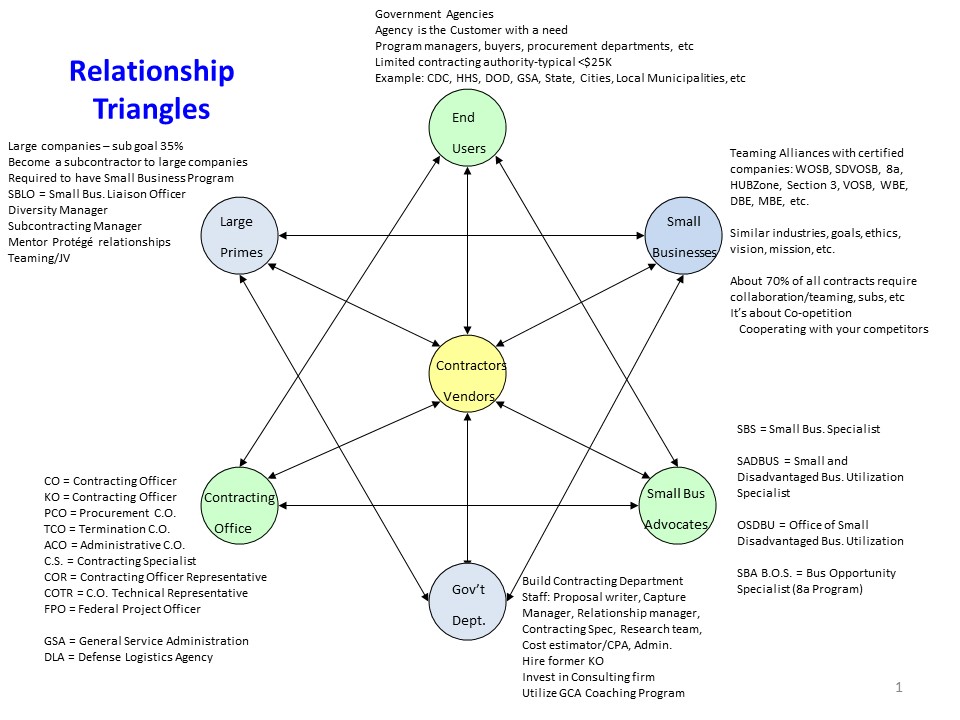6 Key Relationships Every Government Contractors Must Know
6 Key Relationships Every Government Contractors Must Know
In the retail business, it is said that it’s about 3 words… “Location, Location, Location.”
Well, in the government market, the same is true. It also about 3 words, but a slightly different word. Government contracting is about… “Relationship, Relationship, Relationship.”
So, why is a relationship so important in the government market? How do you go about finding those relationships and how do you nurture them?
For small businesses, relationship is king in the government market for two main reasons, Set-Asides and Sole Source Contracts. To receive these types of contracts depends on how strong your relationship is with a contracting officer or a program manager.
It is said that building a relationship in the government market is about “KLT”.
K = Know
L = Like
T = Trust
Old Standard:
“It’s not what you know but who you know.”
New Standard:
“It’s not what you know or who you know, but who knows you back.”
You can know people, but until they know, like and trust you, there will be very little business opportunities.
Keep in mind that the government is risk-averse. They don’t like taking risks. They want to entrust a project to a company that they believe will do the work correctly and in a timely manner. This is called being responsible and responsive or R&R. When you foster a relationship where there is KLT and can demonstrate R&R, the contracting officer will be open to sole sourcing a contract to your business.
There are six types of relationships which you must build to maximize your chances of success in the government market.
As a vendor or contractor in the government market, you must fully understand these types of relationships and how they work together:
- END USER: The agency is the end-user. They’re often called the client. This could be the department director, the program manager, a supervisor, or someone who has a need in the agency. When an end-user needs something, they have very little contracting authority. They have a need and the budget to purchase a product or service, but they don’t have the ability to bind the government into a contractual relationship with a contractor. This is where the next type of relationship comes in.
- CONTRACTING OFFICE: The contracting office acts as the buyer for the agency or the end-user. They are made up of contracting officers or KOs. They must understand the procurement rules and regulations. Often, these professionals must attend Defense Acquisition University to learn how to buy on behalf of agencies. This can be years of training before they can have contracting authority to handle millions or billions in contracts. KOs understand the F.A.R. or federal acquisition regulation. This is the contracting Bible. GSA is a great example of a contracting office which buys on behalf of agencies. Below are different roles and titles:
- CO = Contracting Officer
- KO = Contracting Officer
- PCO = Procurement C.O.
- TCO = Termination C.O.
- ACO = Administrative C.O.
- S. = Contracting Specialist
- COR = Contracting Officer Representative
- COTR = C.O. Technical Representative
- FPO = Federal Project Officer
- GSA = General Service Administration
- DLA = Defense Logistics Agency
- SMALL BUSINESS ADVOCATES: The Small Business Advocate or Specialist (SBS) is the arm of the government which engages with small businesses to help them work with their agency. They often do outreach events, matchmaking events, industry days or small business connection events. There are multiple names which they go by:
- OSDBU = Office of Small and Disadvantaged Business Utilization.
- OSBP = Office of Small Business Programs
- SBA B.O.S. = Business Opportunity Specialist
- SADBUS = Small and Disadvantaged Business Utilization Specialist
- Others….
- LARGE/PRIMES: Large companies are often prime contract holders. Generally, large primes are required to subcontract 35% of projects over $750,000 to small businesses. This requirement is part of their small business program which indicates how they intend to utilize small businesses. When a large prime submits a proposal, it must include a small business plan. This plan is managed by the Small Business Liaison Officer or SBLO. This person may go by other titles, such as a diversity manager or subcontracting manager. A great approach is to subcontract, enter into a teaming, joint venture, or mentor protégé relationship.
- SMALL BUSINESSES: Approximately 70% of government projects require two or more companies to perform on the project. An effective strategy is to team up with other certified small businesses. Finding and building a close relationship with certified companies that have certifications such as WOSB, SDVOSB, 8a, HUBZone, Section 3, VOSB, WBE, DBE, MBE, or other types of certifications will be useful. Certain agencies have a preference of which contracting vehicles or certifications they like to utilize. Search for companies in parallel industries with similar goals, ethics, vision, or mission. Cooperating with your competitors is a good approach to adding capabilities to your company without adding the overhead.
- GOVERNMENT DEPARTMENT: The ultimate goal is to build a strong government contracting team or a department. This team includes in-house roles and outsourced support. In the early stages, one person may wear many hats, but as your team matures, you’ll need to fill all these positions:
- Proposal writer
- Capture Manager/Relationship manager
- Contracting Specialist
- Research team/Opportunity sourcing
- Cost estimator/CPA, Admin.
Often, you may consider hiring a former KO, consulting firm, or ex-military officer to help you build your government team.
The above are the 6 key relationships which you want to know. The more intimately you get familiar with each type, the greater your chance of success.
ABOUT THE AUTHOR:
Abraham Xiong is President of Government Contractors Association, Inc., a professional association dedicated to supporting businesses in the contracting market. He is a social entrepreneur, a business coach, and an avid advocate for small and disadvantaged businesses.
Mr. Xiong is the Co-Founder of the software program called www.GovGenie.com which is a full-life cycle government contracting tool.
Copyright © 2020 All Rights Reserved GCA and GovGenie.com


